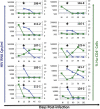Latent HIV-1 infection of resting CD4⁺ T cells in the humanized Rag2⁻/⁻ γc⁻/⁻ mouse
- PMID: 22013038
- PMCID: PMC3255863
- DOI: 10.1128/JVI.05590-11
Latent HIV-1 infection of resting CD4⁺ T cells in the humanized Rag2⁻/⁻ γc⁻/⁻ mouse
Abstract
Persistent human immunodeficiency virus type 1 (HIV-1) infection of resting CD4⁺ T cells, unaffected by antiretroviral therapy (ART), provides a long-lived reservoir of HIV infection. Therapies that target this viral reservoir are needed to eradicate HIV-1 infection. A small-animal model that recapitulates HIV-1 latency in resting CD4⁺ T cells may accelerate drug discovery and allow the rational design of nonhuman primate (NHP) or human studies. We report that in humanized Rag2⁻/⁻ γ(c)⁻/⁻ (hu-Rag2⁻/⁻ γ(c)⁻/⁻) mice, as in humans, resting CD4⁺ T cell infection (RCI) can be quantitated in pooled samples of circulating cells and tissue reservoirs (e.g., lymph node, spleen, bone marrow) following HIV-1 infection with the CCR5-tropic JR-CSF strain and suppression of viremia by ART. Replication-competent virus was recovered from pooled resting CD4⁺ T cells in 7 of 16 mice, with a median frequency of 8 (range, 2 to 12) infected cells per million T cells, demonstrating that HIV-1 infection can persist despite ART in the resting CD4⁺ T cell reservoir of hu-Rag2⁻/⁻ γ(c)⁻/⁻ mice. This model will allow rapid preliminary assessments of novel eradication approaches and combinatorial strategies that may be challenging to perform in the NHP model or in humans, as well as a rigorous analysis of the effect of these interventions in specific anatomical compartments.
Figures



References
Publication types
MeSH terms
Substances
Grants and funding
LinkOut - more resources
Full Text Sources
Other Literature Sources
Medical
Molecular Biology Databases
Research Materials

